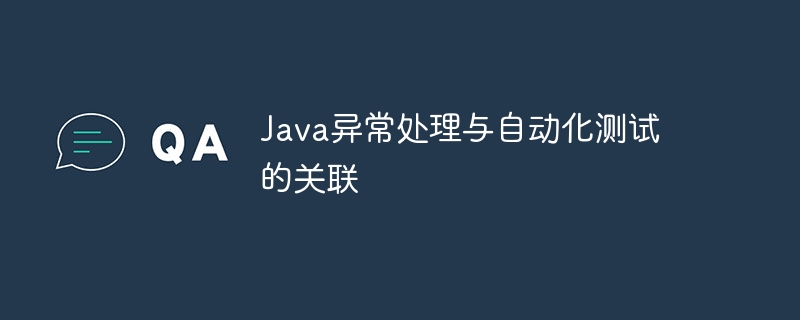Home >Java >javaTutorial >The relationship between Java exception handling and automated testing
The relationship between Java exception handling and automated testing
- PHPzOriginal
- 2024-05-01 22:39:02641browse
Java exception handling and automated testing are closely related. Through error verification, test coverage and exception injection, automated testing helps ensure that the exception handling code works properly. Practical cases show that exception handling can prevent applications from crashing due to exceptions (such as null pointer exceptions), and automated testing can verify that exceptions are handled correctly.

The relationship between Java exception handling and automated testing
In Java development, exception handling is to deal with unexpected situations in the application Basic techniques. Likewise, automated testing is a crucial process for validating application behavior. There is a strong connection between the two, and understanding this connection is critical to writing robust code and effective test suites.
Exception handling
An exception is an event that indicates that an unexpected situation has occurred while the application is running. When an error or exception occurs, the Java Virtual Machine throws an exception object. Exception objects contain detailed information about the error, such as error type and message.
Handling exceptions is important as it enables developers to detect errors and take appropriate recovery measures. Without exception handling, errors can cause unexpected application termination or erratic behavior.
Automated Testing
Automated testing is a process that uses scripts or code to verify the behavior of an application. It can help ensure applications work as expected and reduce the burden of manual testing.
The relationship between exception handling and automated testing
The relationship between exception handling and automated testing is mainly reflected in the following aspects:
- Error verification: Automated testing can verify that the application behaves as expected when it encounters an exception. For example, testing can verify that the application correctly catches exceptions, displays error messages, and takes appropriate recovery actions.
- Test Coverage: Exception handling code paths are often overlooked, resulting in low test coverage. Automated testing can force testing of these code paths to ensure they work as expected under different circumstances.
- Exception injection: Automated testing frameworks can be used to inject exceptions into applications to simulate unexpected situations. This allows developers to verify the robustness and resilience of their applications.
Practical case: Null pointer exception
The following is a practical case illustrating the relationship between exception handling and automated testing:
public class Main {
public static void main(String[] args) {
String name = null;
try {
System.out.println(name.length());
} catch (NullPointerException e) {
System.err.println("Name is null!");
}
}
}In this case, the name variable is initialized to null and then attempts are made to get its length. This results in NullPointerException.
You can use an automated testing framework to verify that the application handles exceptions correctly. This test can verify the following:
- Whether the application caught the exception
- Whether the application displayed an error message
- Whether the application performed appropriate recovery actions
By writing automated tests for exception handling, you can minimize the risk that your application will crash or behave unexpectedly due to exceptions.
The above is the detailed content of The relationship between Java exception handling and automated testing. For more information, please follow other related articles on the PHP Chinese website!

